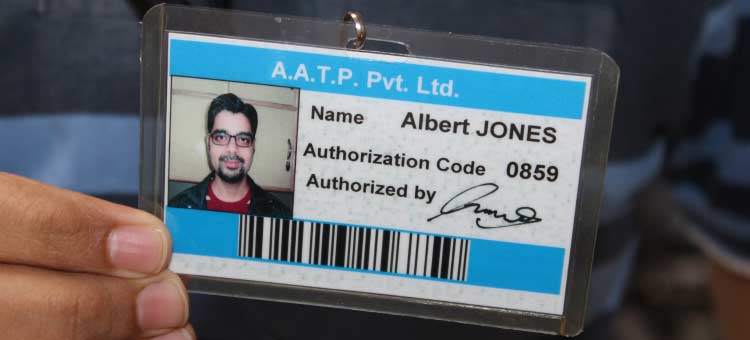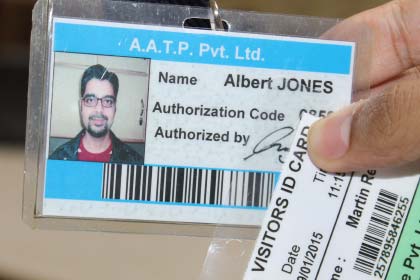Visitor ID Card: Disposing Process, Environmental Impact, and Cost
| 13/07/2023
The process for disposing of visitor ID cards once they are no longer needed depends on the materials used in their production and the organization's waste management practices. Here is a general outline of the disposal process for visitor ID cards:

-
Identify Disposal Method:
Determine the appropriate disposal method based on the type of ID card material. Different materials have varying recycling capabilities and environmental impacts. PVC cards, for example, can often be recycled, while other materials like paper or biodegradable plastics may be suitable for composting or general waste disposal.
-
Data Removal:
Before disposing of the ID cards, ensure that all sensitive or personal information is securely erased or destroyed. This is crucial to protect visitor privacy and comply with data protection regulations. Electronic visitor management systems should have mechanisms in place to securely delete visitor data associated with the ID cards.
-
Separation of Components:
If the ID cards have multiple components, such as a plastic card, adhesive overlay, or lanyard attachment, it is advisable to separate them before disposal. This facilitates proper recycling or disposal of each component as per their respective materials.
-
Recycling:
If the ID cards are made of recyclable materials, such as PVC or bio-based plastics, recycling is an environmentally friendly option. Contact local recycling facilities or waste management authorities to inquire about specific recycling programs for PVC cards or other materials. Some organizations partner with recycling vendors or card manufacturers who provide recycling services.
-
Secure Shredding:
If the ID cards contain sensitive information and cannot be recycled or composted, consider shredding them using a secure shredding service or in-house shredder. This ensures that any remaining personal information is irretrievable.
-
Composting:
If the ID cards are made from biodegradable materials, they may be suitable for composting. Check with local composting facilities or composting programs to ensure they accept the specific type of material used in the ID cards. Composting offers an eco-friendly option for breaking down organic materials and returning them to the soil.
-
General Waste Disposal:
If the ID cards cannot be recycled or composted, they should be disposed of as general waste. This typically involves placing them in designated waste bins or containers for regular collection by waste management services. Ensure that the ID cards are properly secured or shredded to prevent unauthorized access to any remaining personal information.
-
Document the Disposal:
It may be advisable to keep records or documentation of the disposal process, particularly for organizations that need to demonstrate compliance with privacy regulations or waste management practices. Documenting the disposal method used, dates, and any associated certifications or receipts can help establish a record of proper disposal.
-
Visitor ID Cards: Validity, Tracking, and Handling of Lost or Stolen Card
The validity of visitor ID cards can vary depending on the specific...
-
Visitor ID Card: Managing, Issuing Process, and Usage
Visitor ID cards are commonly issued and managed by organizations...
-
Visitor ID Card: Types, Security Features, and Access Control System
The choice of ID card type depends on factors such as the...
-
Visitor ID Card: Difference with Employee ID Card and Customization
A visitor ID card and an employee ID card serve different purposes...
Cost of Creating and Managing Visitor ID Cards
The cost of creating and managing visitor ID cards can vary depending on several factors, including the organization's specific requirements, the size of the facility, the chosen technology, and the level of integration needed. Here are some cost considerations to keep in mind:

-
Hardware and Software: Electronic visitor management systems typically require hardware components such as self-service kiosks, tablets, or badge printers. The cost of these devices can range from a few hundred to several thousand dollars per unit. Additionally, there may be licensing fees associated with the visitor management software, which can vary based on the vendor and the features included.
-
Customization: If you require specific branding or design elements on the visitor ID cards, there may be additional costs associated with customization. This could involve graphic design services, card printing equipment, or specialized cardstock.
-
Integration: If you need to integrate the visitor ID card system with existing access control systems, employee directories, or other databases, there may be costs involved in the integration process. This can include development work, software licenses, or consulting services.
-
Support and Maintenance: Ongoing support and maintenance are important for the smooth operation of the visitor ID card system. This can involve software updates, troubleshooting, and technical support. Some vendors offer support packages with annual fees or subscription models, while others may charge on an as-needed basis.
-
Training and Implementation: Depending on the complexity of the system and the number of users, there may be costs associated with training employees on how to use the visitor management system effectively. This can include on-site training sessions, user documentation, or online training modules.
-
Scalability: If you anticipate a high volume of visitors or the need to expand the system in the future, it's important to consider the scalability of the solution. Some systems may require additional licensing fees or hardware upgrades as the number of visitors increases.
It's challenging to provide an exact cost estimate without specific details about your organization's requirements and preferences. I would recommend reaching out to vendors or service providers in the visitor management industry to discuss your needs and request tailored pricing information. They will be able to provide you with a more accurate cost estimate based on your specific situation.